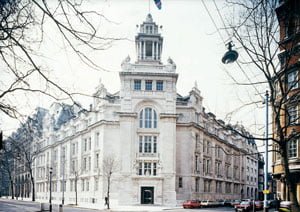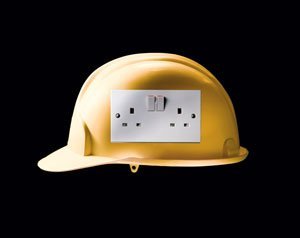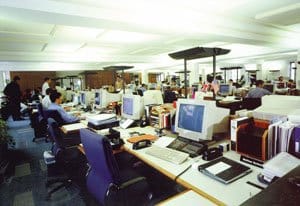
There is little doubt that energy is central to our lives. Indeed, it is impossible to imagine our offices, schools or homes without energy. In today’s complex, competitive international market-place, it is essential that energy is provided in the most efficient way possible. Evolving industrial and consumer energy needs require dynamic supply and service organisations prepared to create change in order to ensure and improve efficiency.
Enron’s history is closely linked with market liberalisation, innovation and a willingness to embrace change – whether that be providing innovative solutions to energy needs or, more recently, investing in environmentally progressive technology. Enron is a leading integrated energy marketer of natural gas, crude oil, electricity and liquids in North America, Europe and the rest of the world. The company is the largest purchaser and marketer of natural gas and the largest wholesale marketer of electricity in North America. It is a leader in providing physical and financial natural gas and power products across Europe, and an established power marketer in the Nordic region.
As well as marketing energy, Enron has, in recent years, developed an important base of power generation plants and this capacity is growing. Enron entered the UK gas and electricity markets with the construction of a natural gas-fired power station in Teesside, which began commercial operation in 1993. The completion of a new natural gas-fired power station in Sutton Bridge in March 1999 will provide an additional, clean, reliable, low-cost source of power for the UK.
The company’s day-to-day activities are based on three core businesses:
- Energy marketing – this group’s operations include the buying, selling, physical transportation and storage of natural gas, crude oil and natural gas liquids, as well as the buying, selling and transmission of power.
- Risk management – this group manages risk for customers through various products such as swaps, options and fixed price contracts. In simple terms, managing risk involves protecting customers against possible fluctuations that may occur in the price of energy over time.
- Finance – this group provides customers with access to low-cost capital for a variety of needs and also provides a range of alternatives for securing affordable debt and equity. For example, Enron may provide a developing company with financing to improve its factories’ use and management of energy. The loan is repaid by the resulting savings in energy costs.
This case study focuses on Enron – a dynamic company which is committed to innovation and change in order to provide solutions to the energy needs of consumers in the UK and elsewhere.
Energy liberalisation and privatisation

In the UK, until the mid 1980s, the electricity and gas sectors were government-owned and controlled. British Gas was the vertically integrated monopoly entity responsible for gas transportation and supply; the Central Electricity Generating Board the monopoly entity responsible for electricity generation and high voltage transmission. Twelve Regional Electricity Boards, each with a regional monopoly, were responsible for low voltage transmission and supply to consumers.
During the 1980s, the then-Conservative Government instituted a series of wide-ranging reforms to both of these sectors. British Gas was initially privatised as a vertically integrated monopoly in 1986. Measures to promote competition have since been introduced. The most significant measure has been the voluntary demerger of British Gas’s supply business, now called Centrica plc, last year. Privatisation and liberalisation of the electricity sector began in 1990, but with more stringent measures than in the gas sector. At the outset, monopoly electricity transmission functions have been carried out by separate companies or separately managed parts of a company, and there has been no prohibition on independent companies generating or supplying electricity.
For both sectors at the outset of the reforms, industrial consumers were the only group of consumers who had the right to choose who supplied their energy. The market has slowly been opening up so that soon all residential customers will be able to choose their gas supplier, and towards the middle of 1999, their electricity supplier.
Liberalisation measures have consistently helped create competition, which in turn has provided substantial benefits to all consumers through increased efficiency and market transparency. Competition has led to innovation in technology, risk management products, and reductions in real terms to the price of energy for the consumer. In the near future, much of Europe’s energy market will become open and more competitive, following the natural forces of supply and demand. Consumers of electricity and natural gas will reap the benefits of increased customer choice. However, the transition from structured monopolies to a free market is challenging. The new markets that are emerging favour organisations which are flexible, innovative and willing to take intelligent risks.
Enron makes the change

Enron first experienced and made the transition from a protected to a competitive market with natural gas in the USA. In the early 1980s, buying and selling gas in the USA was a very complex process, involving a vast network of independent pipelines which distributed gas from the producer’s gas field to the final end user. The logistics of this were complicated and costly. When the industry was deregulated, Enron realised that the many existing natural gas lines could be accessed by multiple companies to create a more organised and flexible network to buy gas where it was cheap and to ship it to where it was needed.
Enron began to buy gas on the spot market and to sell it to customers seeking cheaper, yet reliable supplies. In a competitive market, the customers want to buy from the best overall providers of a good or service. Therefore, organisations exposed to competition in the production and marketing of goods are forced to be efficient, reliable, service-oriented and cost-competitive – the consumer can always choose to buy elsewhere.
Core competencies
A core competency is what an organisation does best. Enron’s core competency is supplying energy to its consumers in a way which responds to customers’ criteria about ‘best value’. For example, a steel mill may need a regular long-term supply of gas at predictable prices. Enron therefore devises a customised solution which best meets the customer’s needs – for instance by agreeing to supply gas to the steel mill at a fixed price for a five year period, or at a price which is indexed to the price of steel the company produces. Enron’s solutions are value-driven – they are specifically designed to give the customer the best possible value for money.
The company’s physical gas and electricity assets, its innovation, financial and marketing capabilities, have enabled Enron to pursue new markets and become one of the world’s largest marketers of natural gas and natural gas liquids. Enron is also a world leader in renewable energy through the development of solar and wind energy power plants and the manufacture and sale of solar and wind generation equipment. Through ongoing specialisation at the leading edge of energy supply, Enron has been able to lower consumer supply costs and, at the same time, create new products and more value for its customers.
Over time, Enron’s specialisation has enabled it to enhance its performance in energy trading by fully researching customer needs and requirements, matching the best-suited buyers and sellers, developing sophisticated approaches to the logistics of getting energy from A to B and in managing price risks resulting from price fluctuations. Enron specialises in value creation by managing innovation and responding with creative solutions to energy problems. Indeed, Enron has been ranked repeatedly as the most innovative company in the USA in a survey carried out by Fortune magazine.
The importance of entrepreneurship

Entrepreneurship involves being creative and taking intelligent risks in order to create purposeful change. It means taking the lead rather than following others. Enron thrives in dynamic marketplaces where customers have choice. They can choose whether they want power now or later, whether they value fixed or flexible prices, whether it is practical to invest in solar panels or whether they will consider generating energy on their own site. Although consumers are aware of their own energy needs, they do not always have a clear idea of how many different ways these needs can be met. Enron prides itself on thoroughly researching the markets in which its customers operate in order to be best placed to solve their energy needs.
Enron employees are encouraged to welcome challenges and be independent decision-makers. The employees in the European head office in London comprise more than 30 nationalities and bring great diversity of experience to the company. Although the company is large – 16,000 employees world-wide – it operates as a number of smaller units under a single umbrella. Each of these units is expected to take responsibility for its own decisions, whilst operating in an integrated way with other parts of the organisation. New employees spend time in the various parts of the organisation to acquire the knowledge and skills needed to anticipate and generate change and make the most of internal synergy.
Corporate structure
Enron’s organisational development follows a pattern suited to a dynamic organisation. The organisation initially started out as a pipeline company. However, it has evolved into production, operating, marketing and finance groups. These groups are organised in small business units which compete independently and focus on their individual businesses, yet keep an eye out for synergies.
As Enron employees develop new ideas, they break them down into smaller components and assess the risks and rewards involved in each of these parts. New ideas are evaluated by a range of people in the organisation in order to provide valuable feedback.
Corporate Philosophy
Enron has a central corporate philosophy which is easy to understand once you are familiar with the background and history of the organisation. First and foremost, Enron is a market-focused organisation, i.e. it focuses on customer needs and requirements. Enron’s vision statement sets out the core beliefs of the organisation:
“We begin with a fundamental belief in the inherent wisdom of open markets. We are innovative. We are all about creating energy. We operate safely and with concern for the environment. We treat others as we would like to be treated ourselves. We are satisfied with nothing less than the very best in everything we do.”
Key aspects of this vision are that:
- Economic activities are better sorted out by open markets than by governments. Customers should be free to make a choice in their energy purchases.
- Enron is a laboratory for innovation. The company therefore employs people who will make good use of opportunities provided to develop themselves within the organisation. Individuals are encouraged to be creative and to contribute to generating dynamism within the organisation.
- Diversity is regarded as an essential attribute of the organisation. Enron believes in employing individuals from a diversity of backgrounds, aspirations and orientations, in order to maximise the input of new ideas.
- The success of the organisation is measured by the success of Enron’s customers. Enron believes in partnership so that progress can be shared with customers.
- Enron believes that one of the best ways it can create ‘added value’ is through respect for the environment, which will enhance the lives of present and future generations.
- Enron believes that everything it does can change people’s lives in significant ways. Enron is reinventing the fundamentals of the energy business by providing energy at better value and in more usable forms than it has been provided before. Enron is changing the way people and companies think about energy.
Everything Enron does is about change – reinventing the organisation and the way it operates has become a habit. Innovative employees assume that the market will change every day and believe that change is to be accepted, welcomed and generated. Work environments at Enron are designed to facilitate discussions and idea exchanges.
Conclusion
In most companies, a good idea is a fragile thing. Enron’s President, Jeffrey K. Skilling, says:
“like a lighted match, easily blown out by the cold winds of rigid management”
Traditionally, large companies find it harder to embrace change than small, entrepreneurial companies. Enron, however, is an exception. Enron looks for markets which are undergoing change, finds out as much as possible about these markets and then provides the best ideas to take these markets forward.
In 1998, 50% of Enron’s income comes from businesses that did not exist 10 years ago – such as electricity trading, international power projects and renewable energy. The best way of highlighting the way in which Enron has generated change is to focus on real examples.
Teesside Power Plant
At the first signs of liberalisation of the UK energy market in the late 1980s, Enron began the development of the 1,875 megawatt Teesside power plant, the world’s largest independent, combined cycle gas-fired power and related large natural gas processing facility. Teesside embodied Enron’s ability to bring together all the aspects of a large-scale infrastructure project, from the acquisition of fuel and the negotiation of long-term electricity and steam contracts to the design, engineering, construction and operation of the facilities.
In addition to the 120 people it employs at Teesside, Enron employs 500 more in its operations in London, Oslo, Madrid, Moscow and Frankfurt. In London, the company operates a sophisticated trading floor, where all energy-related commodities are traded, including natural gas, electricity, natural gas liquids, crude oil and refined products, to markets ranging across Europe, Central Asia, Russia and the Middle East.
Strategic Alliance with Russian Utility
In February 1998, Enron signed a 10-year strategic alliance and a $55 million joint financing project with Unified Electricity Systems (UES) – Russia’s largest electricity utility. The alliance will enable the two organisations to identify joint projects in Russia, Europe and Central Asia and is particularly significant in terms of Enron’s strategy to become a leading energy services provider across Europe. Based in Moscow, UES owns and operates the country’s 57,000 km national high voltage grid, as well as central and regional dispatch centres and substations. The company generates nearly 20% of Russia’s total generation capacity and holds a majority shareholding in 52 of the country’s regional electricity companies.
Clean Energy
Enron has set its sights on becoming world leader in renewable energy. It is developing new lower-cost technologies to generate power from environmentally friendly, renewable energy sources, such as wind, solar and hydro, which will play an important role in future international development. Through a joint venture partnership with Amoco, Enron is exploring a unique opportunity to supply solar rooftop panels for residential and commercial use in Japan. In the state of Nevada, the companies are pursuing a solar project in conjunction with the US Department of Energy.
Through Enron Wind Corp, a leading wind energy power plant developer, operator and manufacturer, Enron is pursuing wind power projects in Brazil, Chile, Greece, Honduras, Italy, Mexico, Spain, the UK and the USA .
In all of the cases highlighted, Enron has sought markets which are undergoing change and has used focused, entrepreneurial teams to start new businesses in these markets, while maintaining and expanding its existing core skills and strengths.
